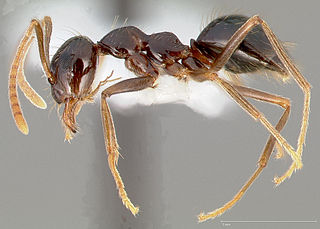
The Formicinae are a subfamily within the Formicidae containing ants of moderate evolutionary development.

Myrmeciinae is a subfamily of the Formicidae, ants once found worldwide but now restricted to Australia and New Caledonia. This subfamily is one of several ant subfamilies which possess gamergates, female worker ants which are able to mate and reproduce, thus sustaining the colony after the loss of the queen. The Myrmeciinae subfamily was formerly composed of only one genus, Myrmecia, but the subfamily was redescribed by Ward & Brady in 2003 to include two tribes and four genera. An additional three genera, one form genus, and 9 species were described in 2006 from the Early Eocene of Denmark, Canada, and Washington. Subsequently an additional fossil genus was moved from the family Rhopalosomatidae in 2018, and a new genus was described in 2021.

Carpenter ants are large ants indigenous to many forested parts of the world.

Plagiolepidini are an ant tribe from the subfamily Formicinae.

Anoplolepis, also known as the "pugnacious ants", is a genus of ants in the subfamily Formicinae and tribe Lasiini. The genus is mainly found in the Afrotropics, with a few native species known from the Malagasy and Oriental regions.

Eutetramorium is a small genus of ants within the subfamily Myrmicinae. To date it contains three species found in Madagascar and Comoros.

Euprenolepis is a Southeast Asian genus of ants in the subfamily Formicinae with eight recognized species.

Paraparatrechina is a genus of small ants in the subfamily Formicinae. The genus contains 39 species distributed in the tropics of Africa, Asia and Australia.

Myrmelachistini is a tribe of ants in the family Formicidae. There are at least 2 genera and 50 described species in Myrmelachistini.

Camponotus castaneus, the red hazelnut carpenter ant, is a species of carpenter ant located in the eastern United States. It is a primarily orangish-red ant in the family Camponotus. Its workers are usually around 8-10 mm, and queens around 18-20 mm. As with most Camponotus species, C. castaneus has majors and super-majors, usually appearing in the second or third year of the colony's founding, majors are usually 10-14 mm, with super majors being around 13-17 mm. C. castaneus has a generalist diet, feeding on insects and carbohydrates such as honeydew, which is easily accessible. The ant has a smooth thorax and abdomen, with 1 node separating them.

Formica ravida is a species of ant in the family Formicidae.

Camponotus chromaiodes, known generally as, the ferruginous carpenter ant or red carpenter ant, is a species of carpenter ant native to the eastern United States, Nebraska, Kansas, and possibly California. Acetobacteraceae are found in the guts of workers in this species.

Formica obscuriventris is a species of ant in the family Formicidae.

Formica moki is a species of ant in the family Formicidae.

Formica neogagates is a species of ant in the family Formicidae. Found throughout North America and Canada, introduced in Europe, France.

Formica archboldi is a species of ant in the family Formicidae. They are known for their abnormal behavior, which includes the collection and storage of Odontomachus (trap-jaw) ant skulls.

Colobopsis is a genus of ants in the subfamily Formicinae. This genus was first described in 1861 by Mayr and contains 95 species. The type species is Colobopsis truncata.
Metalasius is a genus of ants in the tribe Lasiini.


















